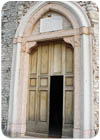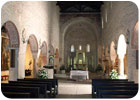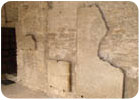
Originally constructed between 712 and 744, and partially reconstructed after the earthquake of 1117, the Church of San Giorgio Ingannapoltron in Valpolicella, Italy, is a blending of architectural styles.

The stone used for the exterior walls, as well as decorative elements such as arches and door surrounds, was quarried from the local hillsides. Today, these materials are sold commercially as “Rosso Verona marble,†which has many different varieties and is among the most storied stones in the world.
Located among the lush hills of Valpolicella, Italy, the Church of San Giorgio Ingannapoltron has undergone several transformations over the centuries, and the existing structure contains work for a range of time periods. Included are stone walls from its original construction in the eighth century as well stonework from its 11th century reconstruction and - following some architectural insensitive modifications - a 20th century interior restoration to its former state.
The church, which was constructed between 712 and 744, sits atop a hill and above archaeological remains of previous sanctuaries of the Roman period, when central and western Valpolicella was still inhabited by the Arusnati. Material from those earlier structures was re-used in the building of the Christian edifice, both in Longobard times between 712 and 744, during the reign of Liutprando, when it was founded, and during the Romanesque period, when it was partially reconstructed after the earthquake of 1117.

Of particular historic interest, the interior of the church still houses the ancient ciborium - a chalice-like vessel used to contain the Blessed Sacrament - carved during the eighth century by the master sculptor Orso and his pupils, Gioventino and Gioviano. As for the actual church interior, work was carried out within the last 50 years to restore the Romanesque architecture, which had been poorly modified over the years.
Like many of the churches of central Europe, San Giorgio Ingannapoltron has two apses and conserves walling devices that suggest their dating from Longobard times, like the ciborium. The church still houses the ancient ciborium - a chalice-like vessel used to contain the Blessed Sacrament - carved during the eighth century by the master sculptor Orso and his pupils, Gioventino and Gioviano. This ciborium, like the church itself, was carved from local marble.

During rebuilding efforts of the church, much of the stonework was reutilized, and historic engraved stone pieces were placed on display.